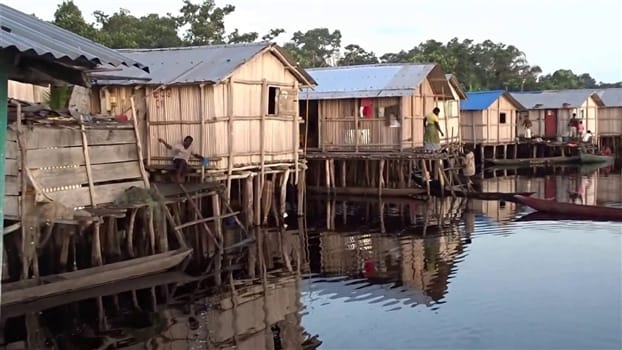Nzulezu: Where Tradition Floats on Water
In the Western Region of Ghana lies a village unlike any other. Nzulezu, the stilt village, is not just a regular village. It is a village entirely built on stilts, sitting on top of Lake Tadane, and is wrapped in serenity. Here, the entire community life takes place on water. The stilt propped pathways of Nzulezu are more than just wooden structures; they are like the veins of a living community that thrive above the gentle ripples of the lake. Nzulezu is a magnificent example of a beautiful bond between a man and nature that can form and live through the centuries.
Historic Background
Stepping into Nzulezu is like traversing through the pages of a living history book. Its nomination as a UNESCO World Heritage Site in 2000 is a nod to its historical and cultural significance, not just to Ghana, but to humanity's heritage.
According to local legend, the village was founded by a group of people from Walata (Oualata). It was a city in the ancient Ghana Empire. Their choice of settlement was a matter of adaptability to their conditions and survival. They had to leave to escape from slave traders. The ancestors of Nzulezu were said to have migrated to this location following a snail, a totem symbol representing protection and guidance. The snail led them to Lake Tadane, where they eventually settled.
The stilt architecture, which is a specifically unique characteristic of Nzulezu, was a pragmatic response to the environment. It was a perfect choice for providing protection against wildlife and other potential threats, while also allowing access to a vital source of food and water from the lake below. Over time, this distinctive living arrangement fostered a unique cultural identity and a symbiotic relationship between the people and the environment.
Exploring Nzulezu
Nzulezu welcomes you with its tranquil ambiance. The gentle murmur of Lake Tadane's waters whispering tales of time. As you wander through the stilt-propped pathways, every creak of wood underfoot resonates with the peaceful flow of daily life in this water-bound haven. In this community, every sunrise brings simple yet profound moments—children laughing as they hurry to school, fishermen casting their nets with hopes of a great catch, and women gracefully balancing their wares as they traverse the 'streets' of Nzulezu. All normal life chores from pounding of fufu (a traditional meal), schooling to baptising, worship and even funerals - all take place here, on water.
This watery village is surprisingly self-sufficient; with its own chief, shops, schools, churches, movie plaza etc. The houses are built on stilts that are made from coconut trees and other hardwoods. Essentially, it is one long pier or “the Main Street” (as the locals call it) with buildings constructed on both sides. On one side of the 'street' are the living quarters, while the other side of the street has businesses, the school, a community centre and other commercial ventures.
Even though Nzulezo village is not connected to electricity, there are a significant number of television poles attached to almost every home in the village. These are powered mostly by car batteries. At night locals use lanterns, flash lights or rechargeable lamps as a source of light to move about. Life here is fully adapted to the watery conditions. It is one of those things about this village that makes it so unique. The village has evolved over centuries, retaining its traditional architectural style while embracing modernity only to a certain extent. The community's lifestyle and the unique architectural design offer a glimpse into a unique cultural adaptation to the geographic and environmental conditions of the area.
Today the village's unique lifestyle draws tourists and even scholars interested in this magnificent interaction between human, culture, and nature. The sustainable practice that generations maintain to this day. The architectural design of stilt construction is just one aspect of this beautiful settlement. This lifestyle has cultivated a community spirit and a harmonious existence with nature.
Nearby attractions
The adventure doesn't end at Nzulezu. The Western Region of Ghana has a wide selection of attractions waiting to be explored.
- Busua Beach
- Axim Beach
- Ankasa Nature Reserve - less popular nature park but not less beautiful. It is a real rainforest environment with the highest rainfall in Ghana.
- Fort Apollonia : is the westernmost Colonial-era fort in Ghana. This is an easy visit because arrangements for Nzulezu are made in Beyin, the beach village where Fort Apollonia is located.
Practical Travel Tips: What to know when visiting Nzulezu
Getting there
Embarking on a journey to Nzulezu requires some preparations. The village is about a 7 hours' drive from Ghana's bustling capital, Accra and about 90km West from Takoradi . If you are visiting one of the beach resorts in the Western Region, such as Busua or Axim, the visit to Nzulezu can be done as a day trip. To get to Nzulezu, you need to get to Takoradi first. From Takoradi take a bus to the Alabokazo junction, and continue the 20km journey to the village of Beyin by taxi or take a minibus parked at the junction.
Getting around by boat
Amansuri Wetlands - one of the highlights of a visit to Nzulezu is the actual journey to get there. Nzulezo is part of the Amansuri Wetland, a ramsar site and the largest inland swamp forest in Ghana. A visit to Nzulezu usually begins at the village of Beyin, where the Nzulezu Reception Centre is located, part of the Amansuri Conservation and Integrated Development Project (ACID). After driving as far as the unpaved road will allow for the current conditions, there will be a short walk to get to your canoe. After payment and a brief safety briefing, life jackets are provided with a guide who will join you as you walk approximately 150m to the wooden walkway to board the boats or rafts. The open top rafts have a maximum capacity of seven adults excluding the guide, with a rowing time of approximately one hour to the village. A canoe ride of 45 minutes to an hour passes narrow, lush channels, open plains, and finally the wide expanse of Amansuri Lake.

Hi, I’m Edite, I am part of the core team of GhanaTRVL and also one of the Insiders.
























Comments